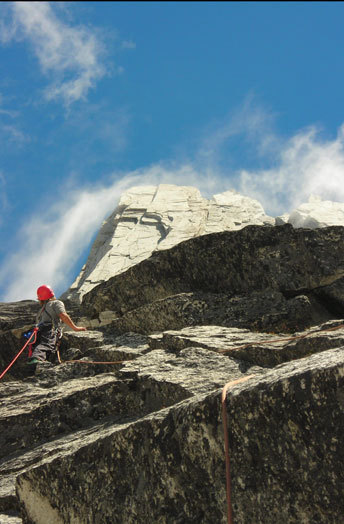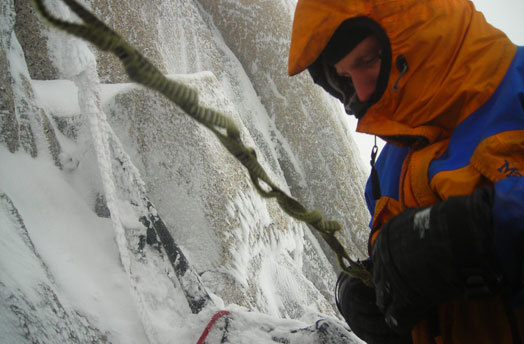
The 3,000-foot west face of North Howser Tower (11,194′), British Columbia, Canada. The red line indicates the line of ascent taken by Dave Russel and Chris Harkness July 8-15, 2006; yellow indicates the line of descent. The climbers are uncertain how their line differed from Warrior (VI 5.9 A3, 34 pitches), established in 1973 by Hugh Burton and Steve Sutton. If their climb is new, they suggest the name Young Warrior (VI 5.9 A3). [Photo] Chris Harkness
I opened the portaledge fly to a world of hoarfrost, whipped into abstract shapes by the incessant wind. It was the second storm on our climb; for the past three days, we’d been stuck near the summit ridge of North Howser Tower, in the Bugaboos, British Columbia. The glacier, thousands of feet below, had long since disappeared in the blizzard.
My climbing partner Dave Russel and I counted up our food again: we’d been on the wall for seven days and our meager three-to-four days’ supply was running out. On the helicopter ride in, our pilot had warned us it could storm here for a month. We were already starving. Despite the weather, we had to begin our descent today. When I stood up, an icy gust knocked me off balance, and I started to lose consciousness. I crawled back into the ledge, ate half a Clif Bar, drank half a cup of hot Gatorade and tried again. Still nauseated, I managed to extract the haul bag from the ice. Two inches of ice had encrusted the rope, and while I jugged up to the ridge, my ascenders slipped several times.
Beyond the crest, the winds doubled in force, now sixty to eighty miles per hour. I pulled out forty feet of rope, tied in and began crawling on my belly through the snow to our rappel point. I was halfway through drilling an anchor when I realized that the rock I’d chosen was loose. My fingers and toes were becoming frostbitten, and the wind was nearly blowing me off the ridge. I realized that Dave and I had grown too weak to survive this kind of exposure, let alone build anchors, rappel 2,200 feet of steep rock with a pig, cross the glacier and ascend another 600 feet of fixed ropes to advanced base camp.
There was nothing to do but return to the ledge and resume waiting.
Magazine pictures can make us far too optimistic. Inspired by a photo in Alpinist (“Mountain Profile,” Issue 14), Dave and I had hoped to make a first ascent on this remote 3,000-foot alpine wall: the west face of North Howser Tower. But the clean, immobile picture soon gave way to a reality of storms–and of rockfall plummeting down our intended route.
I let Dave take the first pitch and hid in the safety of the bergschrund. At the end of the second pitch, however, he informed me that he was not enjoying the wet rock and that he thought we were off route. Reluctantly, I led on through ten pitches of mossy, watery cracks, followed by runout traverses across the face to get back on route and up to the base of the headwall.

Chris Harkness leading Pitch 3 on the first day of the climb. This was the first of ten pitches of mossy, watery cracks, followed by runout traverses across the face, that got the climbers back on route and up to the base of the headwall visible above. [Photo] Dave Russel
After a bivy we started up the nasty gully between us and the solid column system we’d been scoping for months. Suddenly, I heard the crack of rockfall, grabbed a half-driven pin and prayed. I took a dozen shots to the helmet, but none were neck breakers.
“We’re leaving,” I yelled.
But rather than bailing altogether, Dave and I decided to try another line, to the right of Warrior (VI 5.9 A3, 34 pitches, Burton-Sutton, 1973). We spent the afternoon meandering up A3 and 5.9.
Then the storm I’d been dreading all week finally struck.
Hanging on that blank wall, 1,500 feet off the ground, as a black cloud mass rolled toward me, I began to set a hasty anchor. Lightning stuck the valley behind us, igniting a forest fire. When my hammer connected with the drill, a jolt of lightning passed through my right arm, and I fell on my daisy chain. Apart from the initial spasm, though, I was unharmed. During the next forty-five minutes, Dave and I distracted ourselves by shivering and playing “Twenty Questions” until a brief weather window allowed us just enough time to deploy the ledge.
We hid inside for thirty-six hours, listening to Bon Jovi, reading soup-can labels and collecting rainwater. At last I stirred myself to free climb up and left over a verglas-covered face to a huge dihedral. Dave got three pitches of splitter hand to offwidth cracks and a section of rotten aid to gain the summit ridge just as the wind began once more.
The next morning, a cold front brought more snow and wind–and a hard decision: either we’d try to summit that day in the worsening conditions or wait it out. If we made the latter choice, given our dwindling rations, we might not get a second chance. Hours of debate later, we decided to go for it; with rain and lightning no longer a concern, full-conditions alpine climbing now seemed relatively safe.
Soon we entered a maze of gendarmes, clouds and snow. After three hours of wandering up and down slippery rock in low visibility, I strained to find a route that continued up, then looked down to see the summit cairn at my feet. We snapped photos of nothingness. At our high camp, that night, we celebrated with one can of tuna.
By dawn, the blizzard was in full force, and the following day was even worse. We ate nothing, trying to save some energy bars for our descent. When I failed to establish our first rappel station, we both began to wonder whether we’d escape, although neither of us dared express our doubts out loud.

Chris Harkness attempts to unbury the haulbag from the ice on Day 7 of the climb. The climbers had been hit by a blizzard on Day 5 of their ascent. After summitting, they were stranded by the weather for another three days before they were able to descend. [Photo] Dave Russel
On Day 8–July 15–our pants no longer fit, but the storm had started to break. We made eleven rope-stretching (and occasionally more than sixty-meter) rappels down the entire west face with bolts, pins and Stoppers, and at 6 p.m. we were back at the base of our fixed ropes, relieved to find that the snafflehounds had left them untouched. At 11:30 p.m. utterly exhausted, we collapsed at ABC.
The following week was spent eating, resting, and shuttling loads. We found it hard to get motivated to do much of anything, beyond returning to the Kain hut to talk to the first other people we’d seen in eighteen days and to spend the rest of our vacation ticking moderate routes under bluebird skies.
Epilogue
I have been in contact with Hugh Burton (first ascentionist of The Warrior) and Marc Piche (author of the guidebook) and still I am not sure whether we did an FA. Piche’s guidebook makes it seem like The Warrior (VI 5.9 A3, 34 pitches, Burton-Sutton, 1973) follows a majority of the huge dihedral left of our route, but hearing Burton’s description makes it sound like he and Steve Sutton followed a single crack system straight above the bivy ledge. Other than the dihedral, the only crack system in this vicinity that I could see was the obvious weakness that we took. Granted, it climbed some face, disconnected flakes and other small features, but it was the way to go. I saw no evidence of anyone having been on our terrain past the bivy ledge. If our line were new, we’d call it Young Warrior (VI 5.9 A3).